
Vector sets are a Redis data type similar to sorted sets. However, instead of associating each element with a numerical score, elements in a vector set are associated with a vector—a list of floating-point numbers representing the item in a multi-dimensional space.
This makes vector sets ideal for similarity search tasks such as:
- Retrieving the most similar items to the vector of an existing element already in the set.
- Retrieving the most similar items to a specified vector (e.g., a new embedding not yet in the set).
With these capabilities, vector sets are useful in semantic search, recommendation systems, face recognition, and other applications where vector similarity is important.
Vector set: "pg:sts"
├── Element ID: "s1"
│ ├── Vector: [-0.010130, -0.026101, …] (1536 dimensions)
│ └── Attributes:
│ {
│ "sentence": "A young child is riding a horse.",
│ "activityType": "people",
│ "wordCount": 7,
│ "charCount": 32
│ }
├── Element ID: "s2"
│ ├── Vector: [-0.011102, -0.034598, …]
│ └── Attributes: {...}
└── …
A vector set is a collection of elements, each associated with a vector and optional custom attributes.
In above representation:
- Vector set key is `"pg:sts"`
- Element IDs are sentences identified by `"s1"`, `"s2"`, etc., each storing a vector and custom attributes required for future filtering or inspection.
You can add items to a vector set using the VADD command.
VADD {vectorSetKey} VALUES {embeddingDimension} {embeddingValues...} {elementId} SETATTR {elementAttributesAsJSON}Parameters:
- {vectorSetKey} – The name of your vector set.
- {embeddingDimension} – The length of the vector (number of dimensions).
- {embeddingValues...} – The vector values (space-separated floats).
- {elementId} – A unique identifier for this element in the set.
- {elementAttributesAsJSON} – A JSON object containing any metadata about the element, making it easy to filter or inspect later.
VADD "pg:sts" VALUES 1536 -0.010130 -0.026101 ... "s1" SETATTR '{"sentence":"A young child is riding a horse.","activityType":"people","wordCount":7,"charCount":32}'The full Semantic Textual Similarity (STS) Development Set used in this tutorial is available here.
Upload that file into Redis Insight:
- Click `Bulk Actions` -> choose `Upload Data` tab -> upload the file and click `Upload`
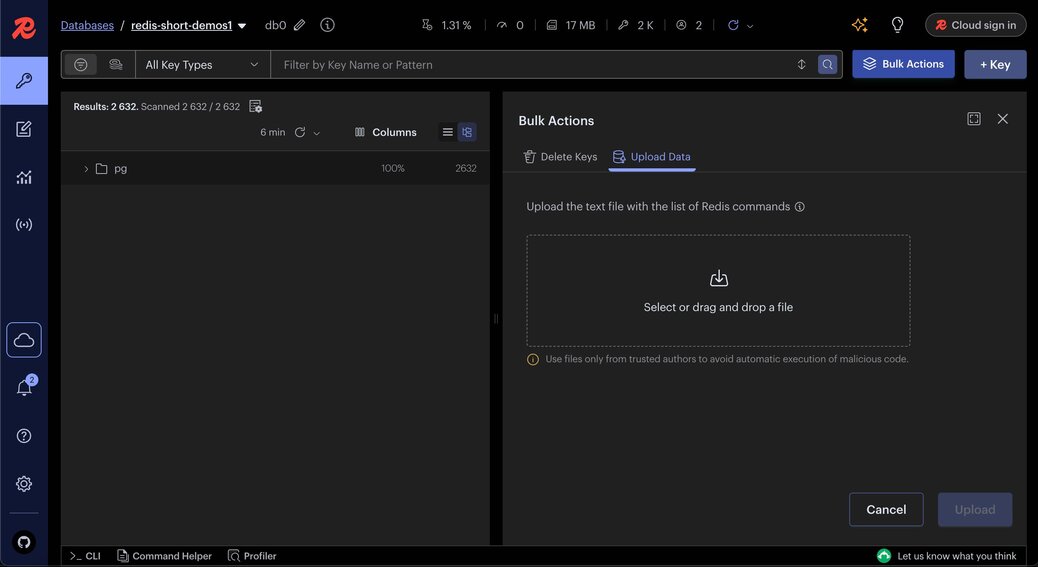
- Post upload, you can see the status of the upload data
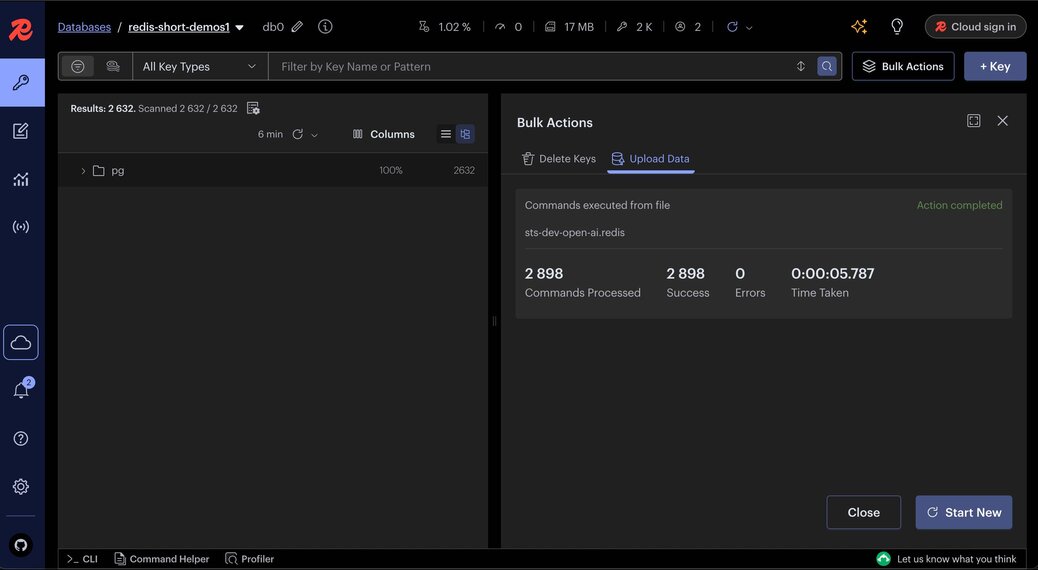
The VSIM command allows you to find elements in a vector set that are most similar to the vector of an existing element in the same set.
This is useful when you already have an element in your dataset and want to find others that are semantically or visually close to it.
VSIM {vectorSetKey} ELE {elementId} WITHSCORES WITHATTRIBSParameters:
- {vectorSetKey} – The name of your vector set.
- ELE {elementId} – The ID of the element whose vector you want to use for similarity search.
- WITHSCORES – Returns the similarity score for each result.
- WITHATTRIBS – Returns the stored attributes (metadata) for each result.
# Retrieve elements similar to existing element 's4' (Sentence 4)
VSIM "pg:sts" ELE "s4" WITHSCORES WITHATTRIBS COUNT 5[
"s4",
"1",
"{\"sentence\":\"The man is feeding a mouse to the snake.\",\"activityType\":\"people\",\"wordCount\":9,\"charCount\":40}",
"s3",
"0.9913436630740762",
"{\"sentence\":\"A man is feeding a mouse to a snake.\",\"activityType\":\"people\",\"wordCount\":9,\"charCount\":36}",
"s424",
"0.9541677162051201",
"{\"sentence\":\"The man is trying to feed the snake with a mouse.\",\"activityType\":\"people\",\"wordCount\":11,\"charCount\":49}",
"s1585",
"0.7106717228889465",
"{\"sentence\":\"As mentioned in previous answers, rats and gerbils can be offered instead of mice or in a rotation with mice.\",\"activityType\":\"other\",\"wordCount\":20,\"charCount\":109}",
"s431",
"0.6881625354290009",
"{\"sentence\":\"The cat tried to eat the corn on the cob.\",\"activityType\":\"animals\",\"wordCount\":10,\"charCount\":41}"
]Query: "Find items similar to element 's4'"
pg:sts
├── s4 (query element)
│ Vector: [...]
│ Attributes: { "sentence": "The man is feeding a mouse to the snake.", ... }
│
├── s3 (score: 0.9913) → "A man is feeding a mouse to a snake."
├── s424 (score: 0.9541) → "The man is trying to feed the snake with a mouse."
├── s1585 (score: 0.7106) → "Rats and gerbils can be offered instead of mice..."
└── s431 (score: 0.6881) → "The cat tried to eat the corn on the cob."You can experiment with Element similarity queries in the Redis Sandbox:
- Element similarity with scores and count example
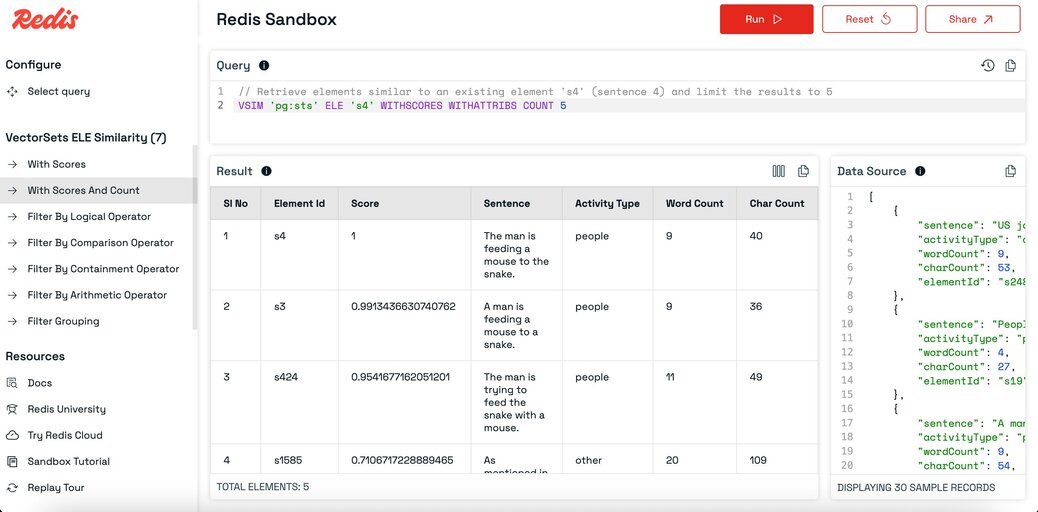
- Element similarity with logical filter
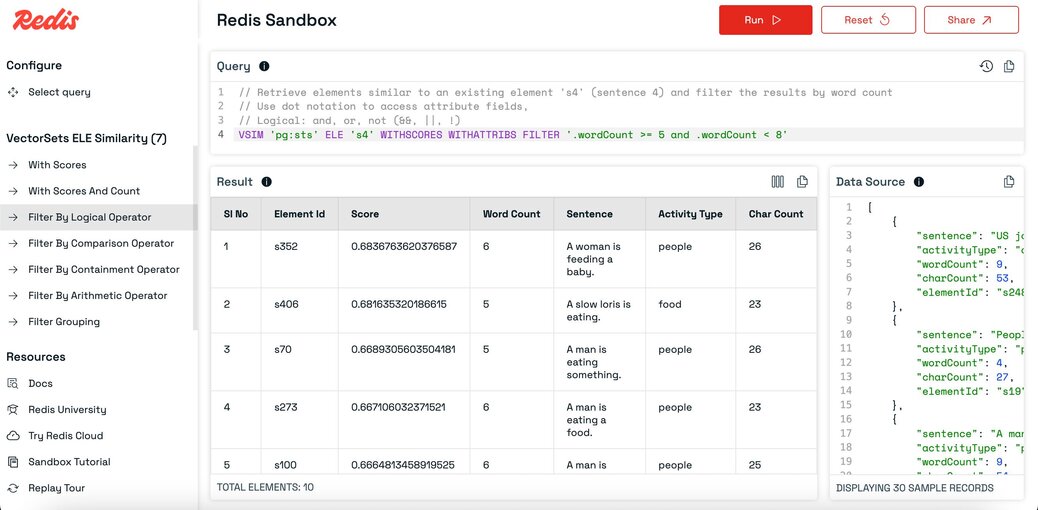
In the Redis sandbox, explore additional filter options in the left sidebar, including arithmetic filters, comparison filters, and containment filters.
The VSIM command can also search for elements similar to a vector you provide directly, instead of using an existing element’s vector.
This is useful when:
- You have a new piece of text, image, or audio not in your dataset.
- You have already generated its vector embeddings using the same model and dimensions used when seeding the vector set.
VSIM {vectorSetKey} VALUES {embeddingDimension} {embeddingValues...} WITHSCORES WITHATTRIBSWhere:
- {vectorSetKey} – The name of your vector set.
- VALUES {embeddingDimension} {embeddingValues...} – The embedding vector to compare against.
- WITHSCORES – Returns the similarity score for each result.
- WITHATTRIBS – Returns the stored attributes (metadata) for each result.
- COUNT N (optional) – Limits the number of results returned.
# Retrieve the top 5 elements similar to the phrase "She is playing a guitar"
VSIM "pg:sts" VALUES 1536 0.000534 0.034054 ... WITHSCORES WITHATTRIBS COUNT 5Before running this query, convert your search text into vector embeddings using the same model (and dimensionality) as the one used to seed the dataset. For example, if the dataset was built using OpenAI’s text-embedding-ada-002 model (1536 dimensions), use the same for the query.
[
"s292",
"0.8956013321876526",
"{\"sentence\":\"The girl is playing the guitar.\",\"activityType\":\"people\",\"wordCount\":6,\"charCount\":31}",
"s117",
"0.8890393897891045",
"{\"sentence\":\"A woman is playing a guitar.\",\"activityType\":\"people\",\"wordCount\":6,\"charCount\":28}",
"s5",
"0.8769233152270317",
"{\"sentence\":\"A woman is playing the guitar.\",\"activityType\":\"people\",\"wordCount\":6,\"charCount\":30}",
"s232",
"0.863240122795105",
"{\"sentence\":\"A woman plays an electric guitar.\",\"activityType\":\"people\",\"wordCount\":6,\"charCount\":33}",
"s271",
"0.8623353093862534",
"{\"sentence\":\"A person is playing a guitar.\",\"activityType\":\"people\",\"wordCount\":6,\"charCount\":29}"
]Query Vector: [0.000534, 0.034054, ...] (1536 dimensions)
Phrase: "She is playing a guitar"
pg:sts
├── s292 (score: 0.8956) → "The girl is playing the guitar."
├── s117 (score: 0.8890) → "A woman is playing a guitar."
├── s5 (score: 0.8769) → "A woman is playing the guitar."
├── s232 (score: 0.8632) → "A woman plays an electric guitar."
└── s271 (score: 0.8623) → "A person is playing a guitar."Experiment with Value similarity queries in the Redis Sandbox:
Value similarity with scores and count example
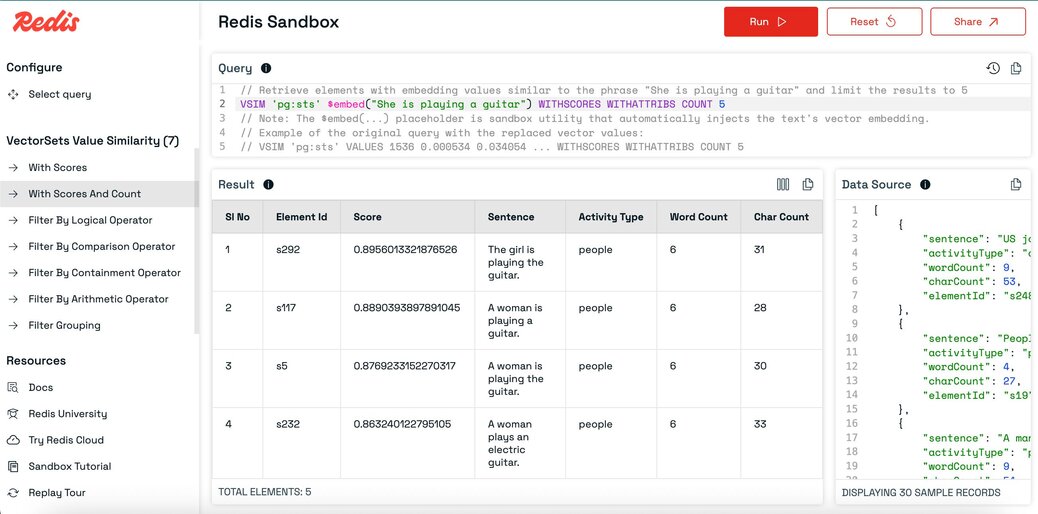
Value similarity with logical filter
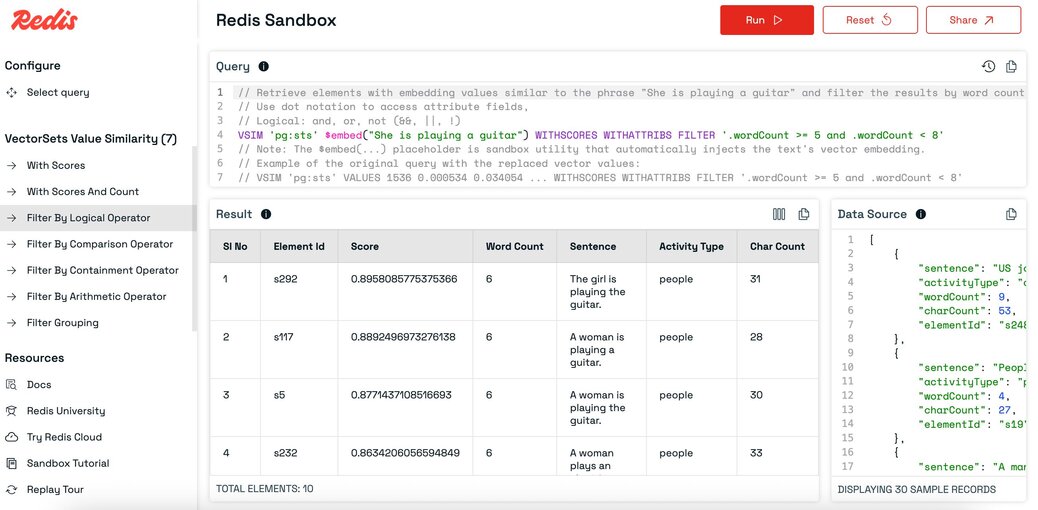
In the Redis sandbox, explore additional filter options in the left sidebar, including arithmetic filters, comparison filters, and containment filters.
Vector sets in Redis support several utility commands that let you inspect, debug, and retrieve metadata, attributes, or structure-related information.
- `VCARD` – Count elements.
- `VDIM` – Get vector dimensions.
- `VEMB` – Get vector for an element.
- `VGETATTR` – Get attributes for an element.
- `VINFO` – Get metadata about the vector set.
- `VISMEMBER` – Check if an element exists.
- `VLINKS` – Get neighbors in the HNSW graph.
- `VRANDMEMBER` – Get random elements.
# Retrieve number of elements in the vector set
VCARD 'pg:sts'
# Output
2898# Retrieve number of dimensions of the vectors in the vector set
VDIM 'pg:sts'
# Output
1536# Retrieve the approximate vector associated with a given element in the vector set.
VEMB 'pg:sts' 's4'
# output
[
-0.000534,
-0.034054,
...
]
# Retrieve the JSON attributes associated with an element in a vector set.
VGETATTR 'pg:sts' 's4'
# Output
{
"sentence": "The man is feeding a mouse to the snake.",
"activityType": "people",
"wordCount": 9,
"charCount": 40
}
# Retrieve metadata and internal details about a vector set, including size, dimensions, quantization type, and graph structure.
VINFO 'pg:sts'
# output
[
"quant-type",
"int8",
"hnsw-m",
16,
"vector-dim",
1536,
"projection-input-dim",
0,
"size",
2898,
"max-level",
5,
"attributes-count",
2898,
"vset-uid",
1,
"hnsw-max-node-uid",
2898
]# Check if an element exists in a vector set.
VISMEMBER 'pg:sts' 's4'
# Output
1# Retrieve the neighbors of a specified element in a vector set. The command shows the connections for each layer of the HNSW graph.
VLINKS 'pg:sts' 's4' WITHSCORES
# Output
[
[
"s3",
"0.9913524389266968",
"s48",
"0.6641438603401184",
"s41",
"0.6403481364250183",
"s143",
"0.6444393396377563",
....
]
]
# Retrieve one or more random elements from a vector set.
VRANDMEMBER 'pg:sts' 5
# Output
[
"s2602",
"s989",
"s409",
"s349",
"s547"
]Experiment with other vector set commands in the Redis sandbox:
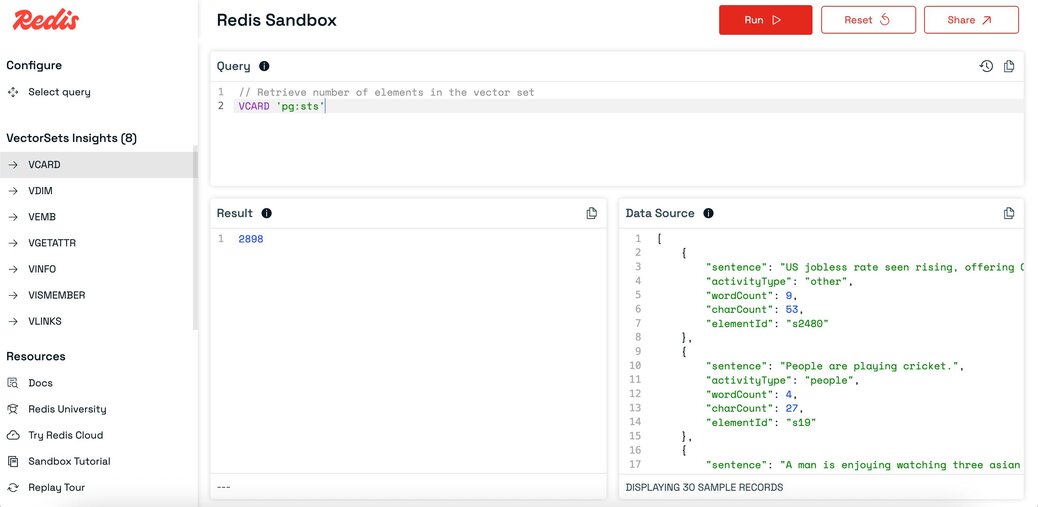
In the Redis sandbox, you can select a command from the left sidebar, click the Run button, and instantly see the output.
You’ve learned how to:
- Add elements to a vector set.
- Run similarity searches using existing or custom vectors.
- Use other utility commands to inspect and explore your data.
Vector sets provide fast, scalable similarity search in Redis — perfect for semantic search, recommendations, and AI-powered retrieval.
Next Steps:
- Try the Redis sandbox links in this guide.
- Import your own data and test queries.- Explore full docs: Vector sets data type